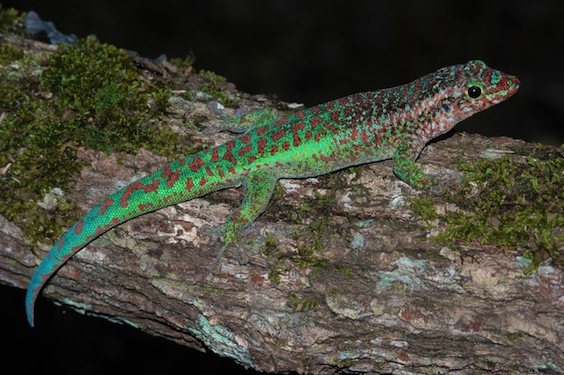
Image © Emmanuel Van Heygen
Distribution
Phelsuma borbonica borbonica occurs in northern Réunion near the capital Saint-Denis and near St. Suzanne, in the higher mountain regions Les Hauts du Brûlé to Les Hauts Mensiol at altitudes ranging between 600 and 990 m, and along the eastern coast from Bras des Lianes to Forêt de Bois Blanc at altitudes between 50 and 950m. Specific locations in the North are Le Brûlé (800 m) near the capital St.Denis, Morne de Patates à Durand (750-880 m) near Bois de Nèfles, Belle-Vue (560 m) near La Bretagne, Beaumont les Hauts (600-900 m) near St.Marie and Les Hauts de la Perrière (630-840 m) near St.Suzanne. Specific localities on the eastern coast include Cascade du Chien (650m) near Bellevue les Hauts, Forêt du Piton Papangue (320-820 m) near Abondance les Hauts, Puy de l’Étang and around le Grand Étang (500 m), Piton Armand (450 m) near Cambourg, Forêt Mourouvin (350-950 m) near St.Rose, Piton Moka (380 m) near Anse des Cascades, Bois Blanc (50 m) and Forêt de Bois Blanc (90-500 m)*.
Terra Typica
Le Brûlé, Réunion Island
Biotope
Phelsuma borbonica borbonica lives mainly on larger deciduous trees at the sun exposed edges or within the primary forests at higher altitudes. The only coastal population is found in Bois Blanc and Anse des Cascades, the most humid coastal area of Réunion island. Here Phelsuma borbonica borbonica is mainly found on Pandanus utilis. In the higher regions and in the rest of the distribution area, the gecko is next to the deciduous trees also found on a smaller species of Pandanus, especially juvenile animals can be found on the lower trees. Adult pairs can be found on the more mature Pandanus trees. Phelsuma borbonica borbonica can also be found on human made objects like electricity poles, traffic signs, reservoirs, uninhabited huts and houses, picnic huts, etc. These objects are often used as mass egg depositing places by several females, larger objects like huts are permanently inhabited by several males and many females. However, they seem to avoid human populated areas, except in the Terra Typica where the animals sporadically can be found on houses. Réunion Island has basically two seasons the austral winter and summer; in the austral winter temperatures often drop below 10° C during night and early mornings within Phelsuma borbonica borbonica 's range with a relative humidity above 90%. The same locations reach a high temperature during the afternoon of 24° C and in the austral summer up to 28° C. Night time drops are not that drastic during summer but humidity remains high as this is also the rainy season.
Description
Males can reach up to 160 mm not exceeding a snout-vent length of 78mm. Females are smaller (130 mm) with a snout-vent length up to 65 mm. A typical morphological feature of Phelsuma borbonica borbonica from the Terra Typica is the whitish-red marbling on the head in the neck region as described by Meier 1995. The dorsal colouration is in most cases turquoise blue as the other subspecies have a green and/or more deep blue dorsal and tail colouration. Head, back and tail are covered with irregular red spots. These occur more organised on the lower back and form a more reticulated pattern in the neck and head region. Two dorsa-lateral areas from behind the eye towards the tail base have fewer and smaller red pigmented scales, and are lighter in colour. The eye-ring is Turkish blue. The ventral colour is whitish with a few red spots.
Other populations in the East are very variable and some of them show a very distinctive blue neck spot, especially the animals found from Grand Etang to Forêt Mourovin. Females are more variable then males ranging from completely green animals, without any red markings to animals as colourful like the more brilliantly coloured males. The eye-ring of all populations in the east is green.
Remark
If Phelsuma borbonica mater is recognised as a valid subspecies, then the animals from the eastern regions deserve a subspecies status as well since they are very distinct from the animals in the northern regions like the Terra Typica.
* No sightings as from February 2004 in Forest de Bois Blanc after extensive searches in February, April and July. The lower regions of the forest still has large areas with plantations like litchi, citrus, banana, vanilla and palmiste (a kind of edible palm). Most probably insecticide has been used as we also found unusual high numbers of land snail shells.
